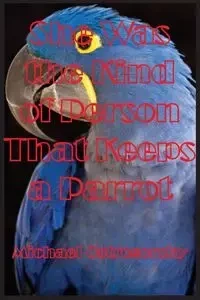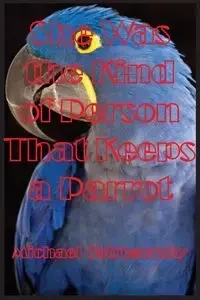She Was the Kind of Person That Keeps a Parrot - Michael Ostrogorsky
- Part Three Kālarātri or Black Night Trilogy
Smart people say the Chicxulub impactor asteroid that smashed into the Yucatán Peninsula sixty-five million years ago, give or take, wiped out the dinosaurs, along with most other life on the planet, this unfortunate occurrence known today as the Cretaceous-Paleogene (K-Pg) extinction event. Parrot people know that dinosaurs still live among us, as parrots.
The K-Pg extinction event marked the end of the Cretaceous Period, the golden age of dinosaurs, and the beginning of the Cenozoic Era that continues today. We know from the fossil record that parrots lived on both sides of the K-Pg extinction event. Parrots, like woodpeckers and owls, are zygodactyl, which is a very dinosaurish sounding name for avian feet with two toes forward and two back, unlike the three forward and one back most modern birds feature. Fossilized zygodactyl tracks have been found dating to 120-110 million years ago (early Cretaceous period), 50 million years before the first identified zygodactyl fossils.
Although controversial, the oldest reputed parrot fossil, found in Wyoming of all places, dates to the Mesozoic Era unceremoniously extinguished by the Chicxulub impactor asteroid. The Wyoming parrot fossil is notable for several reasons. The fossil appears to be part of a fully-formed modern parrot, not an antecedent or prototype. This fossil suggests parrots are older than we expected. Much older. Found in Wyoming, the fossil also suggests parrots did not originate where we expected. Fully modern parrot fossils have been recovered on the near side of the K-Pg extinction event as well. A fully formed parrot fossil dated to the Paleocene Epoch was discovered on Denmark's Isle of Mors, nicknamed Danish Blue in honor of the Monty Python Ex-Parrot. This find is important because the fossil suggests that parrots evolved in the northern hemisphere before branching into widely diverse species in the southern tropics. This fossil evidence suggests parrots are not evolved from dinosaurs, like some modern birds such as chickens. Parrots are dinosaurs. Living, breathing, modern dinosaurs.
The questions remain, how did parrots survive the Chicxulub impactor asteroid when most every other dinosaur did not? And unlike other dinosaurs, which demonstrate a clear evolutionary path through the fossil record, parrots simply showed up. What if the creatures we know today as parrots showed up from somewhere else? Somewhere far, far away. In time and space?
EAN: 9781087889320




Smart people say the Chicxulub impactor asteroid that smashed into the Yucatán Peninsula sixty-five million years ago, give or take, wiped out the dinosaurs, along with most other life on the planet, this unfortunate occurrence known today as the Cretaceous-Paleogene (K-Pg) extinction event. Parrot people know that dinosaurs still live among us, as parrots.
The K-Pg extinction event marked the end of the Cretaceous Period, the golden age of dinosaurs, and the beginning of the Cenozoic Era that continues today. We know from the fossil record that parrots lived on both sides of the K-Pg extinction event. Parrots, like woodpeckers and owls, are zygodactyl, which is a very dinosaurish sounding name for avian feet with two toes forward and two back, unlike the three forward and one back most modern birds feature. Fossilized zygodactyl tracks have been found dating to 120-110 million years ago (early Cretaceous period), 50 million years before the first identified zygodactyl fossils.
Although controversial, the oldest reputed parrot fossil, found in Wyoming of all places, dates to the Mesozoic Era unceremoniously extinguished by the Chicxulub impactor asteroid. The Wyoming parrot fossil is notable for several reasons. The fossil appears to be part of a fully-formed modern parrot, not an antecedent or prototype. This fossil suggests parrots are older than we expected. Much older. Found in Wyoming, the fossil also suggests parrots did not originate where we expected. Fully modern parrot fossils have been recovered on the near side of the K-Pg extinction event as well. A fully formed parrot fossil dated to the Paleocene Epoch was discovered on Denmark's Isle of Mors, nicknamed Danish Blue in honor of the Monty Python Ex-Parrot. This find is important because the fossil suggests that parrots evolved in the northern hemisphere before branching into widely diverse species in the southern tropics. This fossil evidence suggests parrots are not evolved from dinosaurs, like some modern birds such as chickens. Parrots are dinosaurs. Living, breathing, modern dinosaurs.
The questions remain, how did parrots survive the Chicxulub impactor asteroid when most every other dinosaur did not? And unlike other dinosaurs, which demonstrate a clear evolutionary path through the fossil record, parrots simply showed up. What if the creatures we know today as parrots showed up from somewhere else? Somewhere far, far away. In time and space?
EAN: 9781087889320

